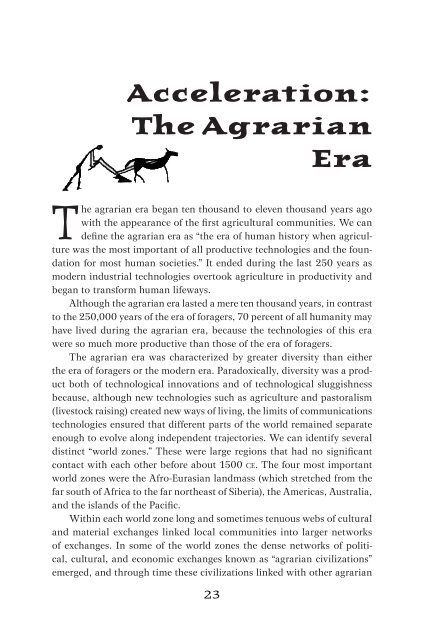This Fleeting World
This Fleeting World
This Fleeting World
Create successful ePaper yourself
Turn your PDF publications into a flip-book with our unique Google optimized e-Paper software.
Acceleration:<br />
The Agrarian<br />
Era<br />
The agrarian era began ten thousand to eleven thousand years ago<br />
with the appearance of the first agricultural communities. We can<br />
define the agrarian era as “the era of human history when agriculture<br />
was the most important of all productive technologies and the foundation<br />
for most human societies.” It ended during the last 250 years as<br />
modern industrial technologies overtook agriculture in productivity and<br />
began to transform human lifeways.<br />
Although the agrarian era lasted a mere ten thousand years, in contrast<br />
to the 250,000 years of the era of foragers, 70 percent of all humanity may<br />
have lived during the agrarian era, because the technologies of this era<br />
were so much more productive than those of the era of foragers.<br />
The agrarian era was characterized by greater diversity than either<br />
the era of foragers or the modern era. Paradoxically, diversity was a product<br />
both of technological innovations and of technological sluggishness<br />
because, although new technologies such as agriculture and pastoralism<br />
(livestock raising) created new ways of living, the limits of communications<br />
technologies ensured that different parts of the world remained separate<br />
enough to evolve along independent trajectories. We can identify several<br />
distinct “world zones.” These were large regions that had no significant<br />
contact with each other before about 1500 ce. The four most important<br />
world zones were the Afro-Eurasian landmass (which stretched from the<br />
far south of Africa to the far northeast of Siberia), the Americas, Australia,<br />
and the islands of the Pacific.<br />
Within each world zone long and sometimes tenuous webs of cultural<br />
and material exchanges linked local communities into larger networks<br />
of exchanges. In some of the world zones the dense networks of political,<br />
cultural, and economic exchanges known as “agrarian civilizations”<br />
emerged, and through time these civilizations linked with other agrarian<br />
23


